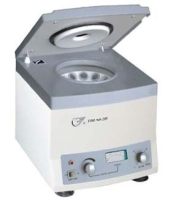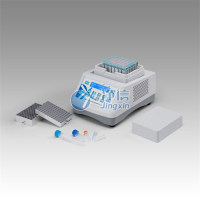美国实验室wetern方法
互联网
WESTERN BLOT PROTOCOL
In a Western blot, proteins that are separated on polyacrylamide gels on the basis of size are transferred to a membrane for detection with antibodies.
Preparation of Human Cell Extracts (per Yasu Itoh, 5/91)
1. Add 2 volumes of autoclaved H
2O for each volume of cell pellet.
2. Bring to 1 mM PMSF.
3. Sonicate on ice (1 sec/ml, 5 times at setting 5). Wait 30 seconds between each sonication.
4. Pellet debris in the microcentrifuge at 13,000 RPM for 5 minutes.
5. Dilute with water to OD
280 = 3.0. Store at -20°C. These stocks should be good for at least one year.
Preparation of Bacterially Expressed Proteins
1. Grow a 10 ml bacterial culture to saturation with the appropriate antibiotic. If IPTG induction is needed, transfer 200 µl of the saturated culture to 10 ml of L broth with antibiotic. IPTG may be added at this time, or the cells may be grown to attain exponential growth before adding the IPTG. Add 10 - 100 µl of 1 M IPTG so that the final concentration of IPTG is from 1 - 10 mM. Induce protein synthesis for 1 - 3 hours. The final yield of protein may be affected by the concentration of IPTG, the induction time, and the bacterial concentration.
2. Centrifuge at 2,500 RPM for 15 minutes at 4°C. Discard the supernatant.
3. Dissolve the pellet in 1 ml of lysate buffer. Bring to 1 mM PMSF by adding 100 mM PMSF stock (17.42 mg/ml in methanol). This solution may be kept for 1 week at -20°C.
4. Add 50 µl of a 10 mg/ml lysozyme solution made in 0.25M Tris-HCl, pH8. Make the lysozyme solution fresh each time. Do not vortex the enzyme. Shake the cells on ice for 15 minutes.
5. Transfer the cell solution to a 4 ml Falcon tube and sonicate at setting "4" for about 10 seconds on ice.
6. Transfer this lysate to microfuge tubes and centrifuge for 15 minutes on high speed (13,000 rpm) at 4°C.
7. At this point, you will need to determine if the antigen is in the supernatant or in the pellet using a Western blot or ELISA. (In the case of the recombinant 52 kD Ro/SSA, the antigenic pellet may be stored at -20°C for about 1 month or -70°C for about 3 months.)
SDS-PAGE Separating Gels (Hoeffer baby gels):
1. For 2 gels, mix in an Erlenmeyer flask in the fume hood with constant stirring under vacuum (to remove air bubbles) for 15 minutes:
6 ml lower gel buffer at room temperature (due to the SDS)
6 ml 40% acrylamide
12 ml double distilled H
20
(-- or use 7.95 ml of 30% acrylamide and 10.05 ml H20 --)
Increase the percentage of acrylamide to analyze lower molecular weight products (less than 30 kD), but continue to use a 10% stacking gel.
2. Assemble the gel holder. Wear gloves to clean the plates with methanol or 95% ethanol. Dry with Kimwipes. Assemble in a gel caster in the following order (for 2 gels):
a). wax paper
b). thick plastic plate
c). thin, flexible plastic spacer plate
d). white glass plate
e). Gray plastic side spacer
f). Clear glass plate
g). thin, flexible plastic spacer plate
h). Repeat 4-7, then clamp sides.
3. Add 0.12 ml of 10% ammonium persulfate solution and 12µl of TEMED (kept at 4°C) to the acrylamide solution prepared above. The APS solution should not be more than 1 week old.
4. Pour the acrylamide solution into the gel holder to about 1 cm above the black mark. This black mark is 3 cm from the top of the plastic holder. Add 1/2 Pasteur pipet full of H
20 saturated butanol to each plate.
5. Wait at least 45 minutes for polymerization then rinse the top of the gels with distilled H
20. These gels may be stored at room temperature for about 1 week in a sealed container with H20 soaked towels to avoid dessication of the gels.
6. Clamp in electrophoresis holder and rinse again with H
2O, then blot the top of the gel with filter paper to remove excess H2O.
Prepare 10% SDS Stacking (or upper) Gel:
1.25 ml upper gel buffer at room temperature
0.56 ml 40% acrylamide
3.2 ml H2O
(-- or 0.75 ml 30% acrylamide plus 3.0 ml H2O --)
30 µl 10% APS solution
10 µl TEMED
Load the upper gel with a Pasteur pipet and add the gel comb. Watch polymerization about every 3 minutes to see if more upper gel solution needs to be added. It should be completely polymerized within 15 minutes. Remove comb and add Tank Buffer to the top with a funnel. Remove any bubbles at the bottom of the gel. Rinse all wells with tank buffer.
Preparation of Sample:
1. Consider volumes to be loaded: For the 1 well comb, load 10 µl of protein molecular weight markers and 500 µl of sample. Use 30 µl of sample per well for the 10 well comb. If a similar gel is prepared for Coomassie blue or silver staining, additional protein needs to be loaded relative to that used for Western blots. See the Coomasie and Silver Staining protocol for details.
2. Add sample buffer to the samples:
~undefined Molecular weight markers from Promega are at 0.5 mg/ml. These are diluted 1:2 in H2O and stored at -20°C. Before use, add 20 µl of this dilution to 10 µl of H20 and 10 µl of 4x sample buffer (or 20 µl of 2x sample buffer). Molecular weights are listed below.
~undefined For human cell extracts add 167 µl of 4x sample buffer to 500 µl of Molt-4 extract (A
280 = 3.0) before heating. This will dilute the sample buffer to a 1x concentration.
~undefined For bacterial cell extracts, dissolve the final antigenic pellet (or heat the bacteria) in 500 µl of 2x sample buffer, then dilute 1:10 in additional 2x sample buffer.
~undefined For insect cells infected with baculovirus, use a lysate from 3000 cells per lane in a 10 well comb with diluted sample buffer.
# Heat samples at 95°C for 10 minutes before loading on the gel.
Electrophoretic Separation of Proteins:
For 1 gel, electrophorese initially at 20 mA constant current. When the dye passed through the stacking gel, increase to 30 mA. Continue electrophoresis until the dye has run off bottom of the gel (less than 2 hours). Alternatively, an overnight electrophoresis may be performed by running the gel until the dye is half through the gel on the above settings, and then decreasing the power to 5 mA overnight. In the latter case, the 31kD molecular weight marker should be at the bottom of the gel in the morning. Disassemble the apparatus, and discard the stacking gel. Notch the bottom right corners of the separating gel and a precut nitrocellulose membrane. Place the membrane on top of the gel, and peel the gel off of the plate.
For 2 gels, follow above procedure but double the current settings.
Electrophoretic Transfer for Dry Blots (Millipore):
Precut three pieces of Whatman 3MM filter paper to the size of the gel. Saturate one filter with working solutions A1, A2, or C, respectively. On the bottom electrode, place in the following order filter A1, then filter A2, the nitrocellulose membrane, the polyacrylamide gel, and finally filter C. Remove any bubbles after each step. Place the top electrode on the stack. Begin transfer at 10-12 constant volts. Regulate voltage to keep the current at 105 mA. Do not allow voltage to exceed 15 V. The minimum transfer time is 40 minutes, the maximum is 60 minutes. You will obtain poor transfer if more than 60 minutes is used.
Electrophoretic Transfer For Wet Blots:
1. Soak the gel(s) and the nitrocellulose membrane(s) in wet blot transfer buffer for a minimum of 15 minutes to remove electrophoresis salts and detergents.
2. For each gel, saturate two fiber pads and two precut Whatman 3MM filter papers in transfer buffer.
3. Assemble on the gray side of a cassette in the following order:
1 fiber pad
1 Whatman 3MM filter paper
Gel
Nitrocellulose membrane
1 Whatman 3MM filter paper
1 fiber pad
4. Repeat with a second cassette for the second gel, if needed.
5. Insert the cassette into the electrode module. Be sure to check the direction so that the transfer is from the gel to the membrane. The gray side of the cassette should be next to the gray side of the electrode module (i.e., the cathode side).
6. Place a stir bar and a Bio-Ice cooling unit (stored at -20°C) in the buffer tank. Place the electrode module in the buffer tank.
7. Fill the tank with wet blot transfer buffer to the bottom edge of the top row of holes on the cassette. Place the buffer tank on a magnetic stir plate and stir at medium speed.
8. Attach electrodes and electrophorese at 100 V for 1 hour, or 30 V overnight.
Detection of Antigen on Membranes:
1. Stain the membrane with 0.1% fast green for 1 minute. Rinse four times with H20. Cut away the molecular weight marker lane and shake it in TBST for 30 minutes (or longer). The rest of the membrane may be sliced in strips, if needed. For a 10 well comb, each well may be cur in half. Notch the left bottom edge of all strips for orientation purposes.
2. Block the membranes in a 5% non-fat milk-TBST solution for at least 30 minutes (overnight is fine) while shaking. For 3 mm strips use about 1 ml of TBST-milk. Membranes may be stored in TBST at 4°C for up to 1 week.
3. Remove the blocking solution. Rinse membranes in TBST once.
4. Add 500 µl for thin sections, or 5 ml for an entire membrane, of serum diluted in 5% milk-TBST. A typical serum dilution is 10
-2. Incubate at room temperature for 30 minutes while shaking.
5. Wash 4 times for five minutes per wash in TBST at room temperature.
6. Add 500 µl of diluted alkaline-phosphatase conjugated secondary antibody and incubate for 30 minutes at room temperature with shaking. (Sigma anti-human IgG conjugate is diluted 1:2000 in 5% milk-TBST).
7. Wash 4 times for five minutes per wash with TBST at room temperature.
8. Add 500 µl of BCIP/NBT substrate (KPL in brown bottle, stored at 4°C). This solution should be yellow, not brown. Wait about 15 minutes for bands to appear. Watch carefully since the reaction times will vary. Rinse with water to stop developing. While the membranes are developing, stain the molecular weight marker lane with 0.1% Amido Black solution for 1 minute, remove this membrane and immediately add to Amido Black destain for about 10 seconds (longer times result in shrinkage of the membrane) before rinsing extensively in H
20.
Photograph the membranes with Polaroid Type 57 film.
Focus with the overhead and focusing lights on, and the shutter and f-stop wide open ("B" and f4.5). Close the shutter. Photograph using only the room lights (focusing lights off) at f8, 1/60 second exposure.
RECIPES
Lysate Buffer (Plasmid Prep Solution #1: 0.1 M NaCl, 50 mM Tris-HCl pH 7.8-8.5, 10 mM EDTA)
For 100 ml, add 2 ml of 5 M NaCl, 5 ml of 1 M Tris-HCl stock at the appropriate pH, 2 ml 0.5 M EDTA and Q.S. with distilled water. Autoclave.
5% Nonfat Dry Milk
Prepare using Carnation Nonfat Dry Milk in TBST.
10% Ammonium Persulfate (APS) Solution
0.12 g APS
1.2 ml H2O)
Keep for no more than week week in the refrigerator.
TBST (10 mM Tris-HCl, 0.15 M NaCl, 8 mM sodium azide, 0.05% tween-20, pH 8.0)
Chemical For 4 liters For 500 ml
Tris 4.84 g 0.61 g Tris
NaCl 35.06 g 4.38 g NaCl
NaN3 2.0 g 500 µl 10% NaN3
Tween-20 2.0 ml 250 µl Tween-20
Adjust pH to 8.0 with HCl. QS with water and store at 4°C.
Tank Buffer (25 mM Tris-HCl, 0.2 M glycine, 0.35% SDS)
Chemical For 4 liters For 500 ml
Tris 12.11g 1.51 g Tris
Glycine 57.6 g 7.2 g
SDS 4.0 g 17.5 ml 10% SDS
QS with H2O. pH should be 8.3 but adjusting is not needed. Store at 4°C
Transfer Buffers:
Wet blot transfer buffer (3L) (25 mM Tris-HCl, 0.2 M glycine, 20% methanol).
9.08 g Tris
43.24 g glycine
600 ml methanol
QS to 3 L with water.
Dry blot transfer buffers
Stock Solution A1 (3 M Tris)
36.3 g Tris, dissolved in double distilled water and QS to 100 ml
Store at room temperature.
Stock Solution A2 (0.3 M Tris)
3.63 g Tris, dissolved in double distilled water and QS to 100 ml
Store at 4°C.
Stock Solution C (0.3 M Tris, 0.4 M aminohexane)
3.63 g Tris, 5.2 g aminohexane, dissolved in double distilled water and qs to to 100 ml.
Store at 4°C.
Dry Blot Working Solutions (made from fry blot transfer buffers)
7 ml H20
2 ml Methanol
1 ml stock solution of A1, or A2 or C
Store at 4°C.
Lower Gel Buffer (1.5 M Tris-HCl, 0.4% SDS, pH 8.8)
For 100 ml:
18.17 g Tris
4 ml 10% SDS
Adjust pH to 8.8 with HCl. QS to 100 ml with water. Store at room temperature.
Upper Gel Buffer 0.5 M Tris-HCl, 0.4% SDS, pH 6.8)
For 100 ml:
6.06 g Tris
4 ml 10% SDS
Adjust pH to 6.8 with HCl. QS to 100 ml with water. Store at room temperature.
4x Sample Buffer (made from stock sample buffer) (0.24 M Tris-HCl, 0.24 M SDS, 40% glycerol, 20% 2-mercaptoethanol, pH 6.8)
8 ml of stock sample buffer
2 ml of concentrated 2-mercaptoethanol
Transfer to 1 ml aliquots and store at -20°C.
2x Sample Buffer (Hoeffer Scientific) (125 mM Tris-HCl, 4% SDS, 20% glycerol, 10% 2-mercaptoethanol, 0.004% bromophenol blue).
Prepare in fume hood!
2.5 ml 0.5 M Tris-HCl, pH6.8 and 4.0 ml of 10% SDS
(--or-- 2.5 ml of upper gel buffer and 3.6 ml of 10% SDS)
2.0 ml glycerol
1.0 ml concentrated 2-mercaptoethanol
0.4 mg bromophenol blue (you may use less but don't add more than 0.4 mg)
QS to 10 ml with water. Transfer to 1 ml aliquots and store at -20°C.
Stock Sample Buffer (from Craig Wasson) (0.312 M Tris-HCl, 0.346 M SDS, 50% glycerol, pH 6.8)
3.03 g Tris
8.0 g SDS
40 ml glycerol
Adjust pH to 6.8 with HCl. QS to 80 ml with water. Store at room temperature.
0.1% Fast Green (in 10% acetic acid and 20% methanol)
0.2 g Fast Green
20 ml acetic acid
40 ml methanol
140 ml double distilled water.
0.1% Amido Black (in 10% acetic acid and 45% methanol)
0.2 g Buffalo Black
90 ml methanol
20 ml acetic acid
90 ml double distilled water.
Amido Black Destain (2% acetic acid, 45% methanol)
225 ml methanol
10 ml acetic acid
QS to 500 ml with double distilled water.






